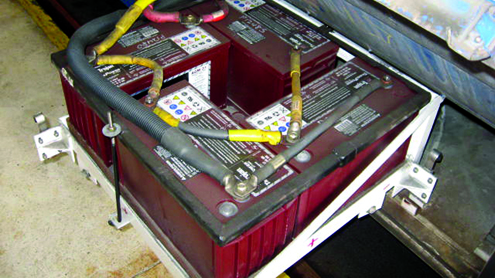
Batteries must match growing demands from greater electrical loads
By Brad Bisaillon

Shrinking budgets paired with the pressure to remain profitable are challenging transit agencies and bus companies to do more with less in the wake. Ensuring the reliability of bus fleets and maintaining low operating costs have resulted in executives more closely scrutinizing bus designs and operating components such as battery technology.
The latest bus models incorporate technology that requires a greater reliance on batteries to supply increased electrical loads to operate such components and accessories such as fare boxes, fire suppression systems and security and surveillance equipment. These new electrical systems put a tremendous strain on the batteries and have caused traditional flooded batteries to prematurely fail.
Maintenance crews are quickly realizing the importance of selecting the right type of battery to effectively manage these more strenuous electrical loads, as well as provide the power to start buses that may have sat idle in the storage yard.
Group 31 AGM batteries are proving to be the best choice for today’s mass transit bus and motorcoach operations. This new technology better handles the deep discharge inherent in these applications while retaining the capability to start the vehicle. This is a shift from 8D and 31 flooded lead acid batteries which were not able to sustain the continuous strain of electrical systems that now require power 24/7.
Not all AGM batteries are the same. There are significant differences in the construction and performance characteristics that determine the ideal regulator setting to maintain the health of the battery and gain maximum life.
Onboard systems like engine ECMs, Vansco and I/O Controls prevent the regulator from being adjusted to any higher than 29.0 volts, narrowing the field of AGM batteries that best suit particular applications. Not all AGM batteries will survive at a charge voltage rate as low as 29.0 volts. Selecting the wrong battery technology could result in dramatically reduced battery life by delivering too high a current at too low a voltage, causing premature failure and unnecessary downtime, which can be costly and detrimental to a transit line’s on-schedule record.
Supercapacitors (also known as ultracapacitors), when used in conjunction with deep-cycle AGM batteries, provide effective power storage and ensure successful engine starting. Ultracapacitors can deliver their storage electrical energy at a high crank rate in a variety of extreme temperatures to provide reliable and consistent starting. Some bus fleets are adopting supercapacitor technology for cranking applications and then employing AGM battery technology to manage auxiliary loads.
Implementing deep-cycle AGM batteries eliminates the need for the routine maintenance required for flooded 8D battery technology. While AGM batteries are sealed and do not require the addition of water, they do “off gas” and should have good ventilation. Nonetheless, employing standard maintenance practices is the best way to keep AGM batteries performing at their highest level.
Evaluating the state-of-charge of AGM batteries is an important part of a regular battery maintenance program. Determining the state-of-charge can be easily done by taking the open-circuit voltage reading using a voltmeter and should be done while the batteries are not under an electrical load. When using an inexpensive digital voltmeter with a basic accuracy of at least 0.5 percent or better, simply attach the positive and negative voltmeter leads to the appropriate battery terminals and read the measurement. When taking measurements using a voltmeter, be sure to do the following:
Wait two hours after any charging to take a measurement. Use the disconnect switches to stop all charging or discharging if necessary.
Ensure the polarity is correct as reverse polarity meter can damage analog meters.
Measure DC voltage across the main positive and negative terminals.
Always consult the manufacturer’s technical specifications to determine the proper charge measurements for your specific batteries.
Voltage readings gradually lower as batteries age. This occurs at a faster rate if technicians have not maintained the batteries regularly and properly. The maintenance team should keep a battery maintenance log to record voltage readings over time, which will help when troubleshooting problems.
Also, if batteries are not in regular use on buses and are stored for long periods of time without being charged, they will self-discharge, and the hotter the temperature the more self-discharge the batteries will incur. However, AGM technology has a much slower self-discharge rate than traditional flooded technology. For these reasons, it becomes necessary to charge batteries that are in extended storage approximately every six months.
As buses and motorcoaches, along with the electrical systems that power them, grow more advanced, the need for more advanced battery technologies will continue to be in demand. Always purchase deep-cycle batteries from companies that have the background and expertise in providing deep-cycle battery technology that can effectively manage bus starting and auxiliary power applications. The proven battery technology providers offer products with the reliability operators count on. BR
Brad Bisaillon serves as sales manager, strategic accounts and transportation for Trojan Battery, Santa Fe Springs, CA.
